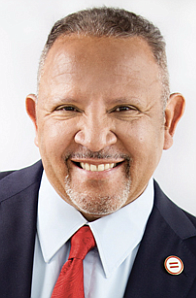Redefining policing in America, by Marc H. Morial
1/25/2024, 6 p.m.
“The only way to get this number down significantly would be to make more significant changes to, you know, what policing means in this country.”—Justin Nix, criminal justice professor, University of Nebraska Omaha
The sheriff’s deputies who shot and killed Tony Cox in Michigan last month said he had a gun. He didn’t.
The deputies said Mr. Cox pointed at them with “a two-handed posture.”
But in the single still image police released — it’s not clear whether it’s from a body camera or dashboard — Mr. Cox is facing away from the camera.
Police in Fayetteville, N.C., who shot and killed DeMarcus Brodie during a traffic stop on Thanksgiving Day haven’t explained why they stopped Mr. Brodie, or how the encounter escalated into violence.
Mr. Cox and Mr. Brodie are two of the 1,329 people killed by police in the United States last year, the deadliest year for police killings since 2013. Black people are three times as likely to be killed by police as white people. Almost 90% of the victims died by gunfire.
It’s no mystery why police killings continue to escalate:
The nation is awash in guns, too many police are poorly trained, and most face almost no accountability.
All of these factors point to the urgent need for the nation to adopt the National Urban League’s Pillars for Redefining Public Safety and Restoring Community Trust.
A comprehensive framework for criminal justice advocacy, 21 Pillars takes a holistic approach to public safety, the restoration of trust between communities and law enforcement, and a path forward for meaningful change.
Each of the 21 Pillars centers on five key themes that are fundamental to the protection and preservation of life, dignity and trust, while also building safer communities:
Collaboration between law enforcement and communities
Accountability
Reform of divisive policies
Transparency, reporting, and data collection
Improved hiring standards and training.
The George Floyd Justice in Policing Act, which the National Urban League emphatically endorses, would accomplish most of the Pillars on the federal level.
About a quarter of those killed by police last year were in the throes of a mental health crisis.
Address the needs of individuals experiencing mental health crisis is Pillar 4.
Campaign Zero, the criminal justice reform advocacy group that compiled the data, notes that at least 42% of the incidents were captured on body-worn cameras, which police often don’t release to the general public. The footage “commonly” contradicts officers’ initial accounts of a fatal encounter.
Mandate the use of dashboard and body-warn cameras and provide public access to the footage is Pillar 15.
Campaign Zero also noted that their research efforts are hampered by the fact that at least than half of police killings are not reported in official government data. Collection of data on police misconduct and use of force is Pillar 14.
Chuck Wexler, executive director of the Police Executive Research Forum, told USA Today that de-escalation training is proven to work, but too few departments have implemented it.
Strengthening police hiring standards and improving training to build integrity and trust is Pillar 20.
“Until that training changes, and until the culture with it changes, that number is going to be way too high,” Mr. Wexler said. “We can cut officer involved shootings with the right training.”
The writer is president of the National Urban League.








